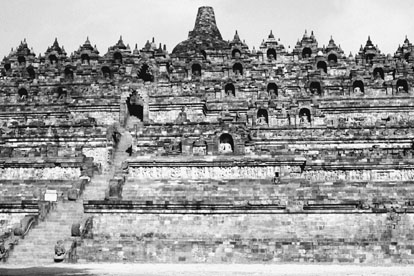

 | Page 652 |  |
of joint programs with teams of foreign archaeologists, and the sending of Indonesian archaeologists abroad to further their education in both the technical and the theoretical fields. The last two achievements have increased Indonesia’s ability to carry out restorations with the support of laboratories, technology, and the appropriate surveys and excavations.

One of the ornate temples at Borobudur, Indonesia
(Corel)
A military coup of 1975 and the rule of the Suharto regime until 1999 drastically affected the organization of archaeology in Indonesia. The state organization for archaeology was divided into two special units, each with its own function and tasks (Soejono 1987). Archaeological activities were divided into two categories, administrative and scientific. The organization in charge of the administrative functions became the Direktorat Sejarah dan Purbakala (Directorate of Archaeology and History), and the organization in charge of the scientific activities was the Pusat Penelitian Purbakala dan Peninggalan Nasional (Center of Archaeological Research and National Monuments). These names have been changed and are now the Direktorat Perlindungan dan Pembinaan Peninggalan Sejarah dan Purbakala (Directorate for Protection and Development of Historical and Archaeological Remains) and the Pusat Penelitian Arkeologi Nasional (National Research Center of Archaeology).
This division is significant for two reasons. First, each division concentrates on its respective area and tackles problems separately. There had been too many and complex administrative and organizational problems for a joint organization to resolve. Second, the division has created more opportunities for scientific work. The division of archaeology has been unified and coordinated with a large and qualified staff, a broad organizational structure, and a sufficiently large infrastructure. It is possible to avoid overlapping activities, and the two official divisions work to develop a national plan of priorities for monuments and archaeology.
National short- and long-term development programs now support a wide range of archaeological projects. These programs have improved conditions for archaeology, and their
 |  |